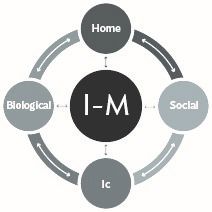Addiction
Is Addiction a Disease? Part 2
Using the I-M Approach to explore addiction
Posted February 2, 2015
Last week I introduced the idea that we are all doing the best we can at every moment in time. I call this our I-M, our current maximum potential. I propose that no one chooses to do worse than their I-M. You are always doing the best you can. This does not mean that your current I-M is the best you will ever do, but that no one chooses to do worse than their I-M. It is in this context that I am looking at addiction, and at the disease idea in general.
I think this is worth repeating: A person with an addiction is still at an I-M. They don’t have to like it nor condone it. They are responsible for their actions. But at that moment in time it is the best they can do. The I-M construct is not saying that who you are, what you are doing, thinking, feeling, at this moment is the best you will ever do. It simply says that at every moment in time people are doing the best they can do at that moment.
Your I-M changes from second to second, yet remains an I-M.
The I-M approach to people ultimately results in unleashing the power of respect. Of all the human desires, I think that feeling respected is one of the most fundamental. Respect leads to value, and in our heart of hearts a person just wants to feel valued by someone else. We want to feel connected, because when we feel connected we feel safer.
Our I-M is influenced by four domains. Two of these domains are internal. They influence how we respond to the two external domains, the source of our connections to the world.

THE FOUR DOMAINS
Internal domains:
How you see yourself and how you think others see you, abbreviated as the Ic Domain.
Your biological domain of your brain and body.
External domains:
Your home environment
Your social environment

These four Domains interact together so that a small change in one Domain can have an amplified and ripple effect in the others. Each time there is a change in any Domain there is a change in your I-M. And as your I-M changes it influences the choices you make in the Domains. This leads to a very important principle of the I-M Approach: Small changes can have big effects. The first time a person picked up a drink or took a hit of weed may have been a small change but with a big effect. In the same way, the first time a person says “No," to that next hit or drink will be a small change with a big effect. If you don’t take that first drink or hit, you don’t have to worry about the second one.
The first Domain I am going to introduce you to I call the Ic Domain, pronounced “I see." In essence, this domain is about our ability to use “Theory of Mind,” our ability to appreciate someone else’s point of view. The label, “Theory of Mind,” (ToM) is a rather clunky and scientific way of saying that, because we can’t actually see someone else’s mind, we have to theorize what they are thinking or feeling. This is the traditional view of ToM: perspective taking and empathy.
But I suggest we extend ToM beyond just empathy.
While we may be interested in what other people are thinking or feeling, what we really want to know is what are they thinking or feeling about us. The Ic Domain becomes the inroad to our understanding of how we see ourselves through the eyes of others. My next book coming out in October focuses on the Ic Domain and Theory of Mind.

The Ic domain is thus how we see ourselves and how we think other people see us. Do you see yourself as having an addiction? Do other people see you that way even if you don’t? Our self-image is very much influenced by how we think other people see us. Your Ic Domain is your current individual concept, your psychology, character, and personality.
The Ic domain is where the power of respect has its entry point. As we perceive how others view us, it influences our own self-concept. How I see the world now is critical to how I interact with the world. And how I think the world sees me, is equally influential. In this third Domain live our thoughts and feelings. Perhaps more than any other Domain, this one helps define who you are and why you do what you do.
Many of my teenage patients will say they don’t care what other people think or feel about them. Many people with addiction feel the same way. When I hear a teenager or adult say they don’t care what other people think or feel I first respond, “But there was a time that you did. What happened?” Invariably the person stopped caring because what they thought the other person thought there was something wrong with them: they were an addict. The fact that the patient stopped caring meant they really do care what other people think or feel about them. They stopped being interested because they perceived that other person saw them as less-than: not doing the best that they could but using drugs and alcohol and “ruining” their life.
As my patients begin to explore when they stopped caring, I then challenge them with this silly question: “Why are you wearing clothes?” We wear clothes because it is the social expectation. We don’t walk around naked! We are always keenly aware that other people have thoughts and feelings and opinions about us. As an adult, you probably didn’t wear your pajamas when you went to a job interview. You “knew” it would give off a particular impression, one that would probably not get you hired.
You also probably won’t reveal secrets that may jeopardize you getting the job. The Ic domain is also Domain of Secrets. A secret is not a secret because of what you have done. A secret is a secret because we worry, “How will someone else view me if they know my secret?” We are very interested in what someone else is thinking or feeling about us.
The Ic domain is also the Domain of self-esteem, self-doubt, self-loathing, and self-importance. This is the place where stigma lives. It is where we see ourselves as valuable and connected to others, or where we feel we have no value and begin to feel disconnected. The more connected we feel, the better we feel and I believe the less likely to use drugs and alcohol to “feel” good. The less connected we feel the greater the risk of using, which then leads to being further ostracized, stigmatized, and judged as less-than. When you see yourself and others at an I-M that judgment falls away. Instead, you can begin to understand why a person is doing what they are doing from a position of respect and not judgment. This can have a profound influence on the Ic domain, and the entire I-M begins to shift.
Have you ever read the “Rose is Rose”, by Pat Brady and Don Wimmer? One of their cartoons beautifully illustrates ToM, the Ic Domain, and the power of the I-M.
In the cartoon Pasqual, a little boy, is playing baseball with his dad. He can’t hit it, throw it, or catch it. He’s terrible. But his dad says to him “You were amazing out there!” and the little boy walks away smiling. Through the eyes of his father he sees himself as valuable.
In the final panel are sitting in a tree, observing the play between father and son. One squirrel does not believe in an I-M. “That kid needs a lot of work” he says, implying “what’s wrong with him? He should be doing better.” But the other squirrel does believe in an I-M. “I remember when you couldn’t climb a tree.” The squirrel is commenting that even when the other squirrel could not climb a tree, at that past moment in time, at that I-M, that was the best the squirrel could do. But now that squirrel can climb a tree, and is at a different I-M. Why say that either one was not the best that squirrel could do at that moment, but now something has changed in any of the four domains, and the squirrel is at a different I-M. You’re I-M has changed. Both as valid, both as valuable, both deserving of equal respect.
But if how we see ourselves is highly influenced by how we think other people see us there is a potential dark side, exquisitely illustrated by a Charlie Brown cartoon by Charles Schulz.
Charlie Brown. Your prototypical depressed kid. Why is he depressed? In one cartoon Charlie Brown is being passed by and ignored by other kids and even Snoopy. As they walk by he says, “Believe in me. Believe in me. Believe in me.” In the final panel he sits alone and says, “I just can’t get people to believe in me.” This is why Charlie Brown is depressed. Through the eyes of others, he is beginning to see himself as a loser, without connection to other people, or even his dog!.
Human beings are interested in what other people think or feel. And if it is always malevolent, a very dark and dangerous things happens: we shut down our interest in what other people think or feel about us. Why would we want to know?
But the real danger is this: When we shut down an interest in what other people think and feel about us, we shut down an interest in what they are thinking and feeling, and we shut down empathy. We stop caring about other people. Unlike the Rose is Rose cartoon which is a world of vibrancy and color, of nuance and connectedness, the Charlie Brown world is black and white. There is no nuance when we shut down empathy. Things are good or bad, and nothing in between. How does being seen as an alcoholic, or a person with a disease of alcoholism, influence the Ic and I-M?
Next week I will explore the biological domain of the I-M Approach, and the resulting feelings and brain responses that happen to use when we think someone else sees us as less than or the best we can. It’s an I-M thing




